Turtles are amazing creatures. They live in water, eat plants, and even lay eggs. But did you know they also live in Texas?
The state of Texas has over 2,500 species of reptiles and amphibians. Some of them include snakes, lizards, tortoises, frogs, salamanders, crocodiles, and our favorite – turtles.
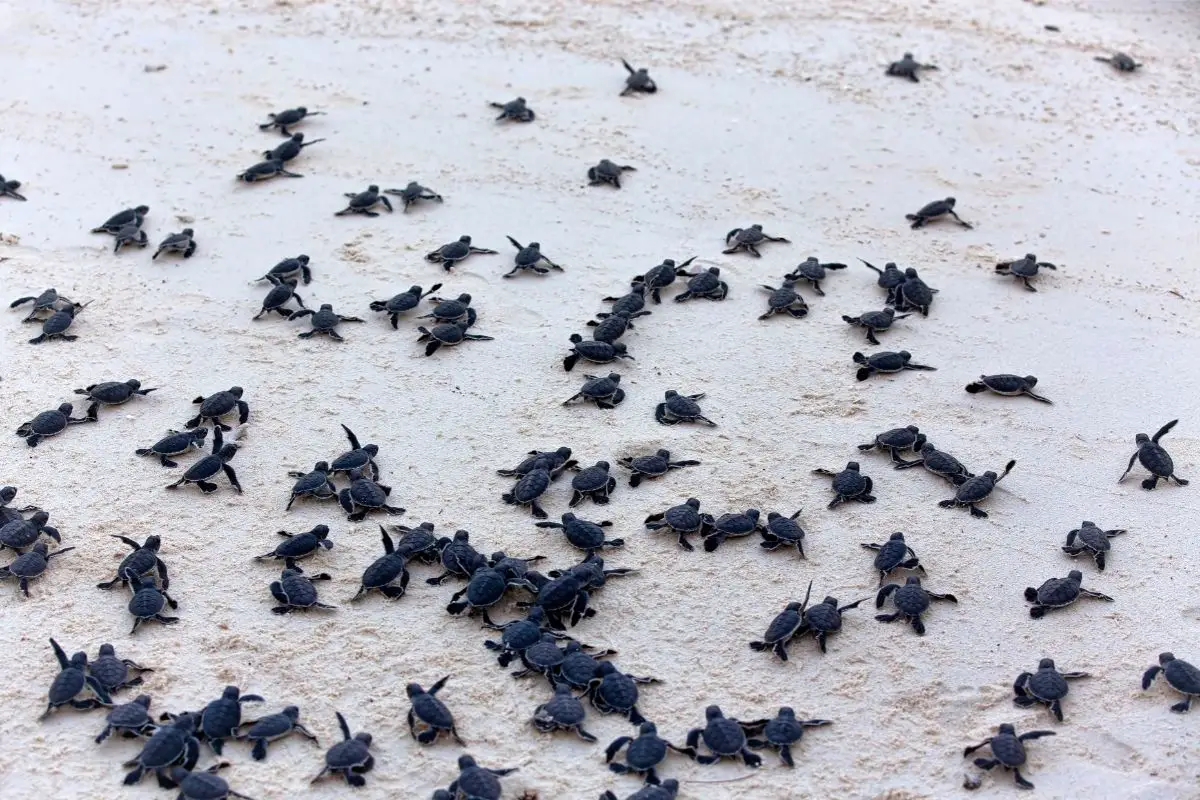
Turtles are a very important part of the Texan waterway ecosystem. That being said, they are under threat from the same dangers that are facing all kinds of wildlife.
In fact, some species are considered endangered or threatened. In this article, we will take a look at some of these animals and how to help protect them.
The Desert Box Turtle

- Latin Name: Tarrapene Ornata Luteola
- Other Names/Common Names: Sonoran box turtle, Sonoran Desert box turtle.
- Lifespan: These turtles naturally live between 30 and 40 years.
- Adult Size: Typically, a mature adult desert box turtle will be between 4 and 6 inches nose to vent.
This box turtle lives in the desert. It is a very common species, meaning that it is easy to spot if you are a beginner turtle fan, and is a subspecies of the Western Box turtle, which you might also be familiar with.
However, different to the Western Box turtle, the Desert Box turtle, they have adapted to live in drier, arid environments, that are often flat and open.
It is also called the Sonoran box turtle because it thrives throughout the Sonoran Desert, which stretches throughout Arizona, California, and multiple Mexican states.
These turtles live in southern Arizona, New Mexico, Texas, and Mexico. They are mostly terrestrial. They eat snails and slugs.
Their average price range is between 300-400 dollars if you want to purchase one for your reptile collections – but only ever purchase turtles from a reputable pet shop.
Desert box turtles have domed shells that come in both red and brown colors. Their markings are usually thinner than those of ornate box turtles, which you may mistake them for.
Desert box turtles are omnivorous and mostly feed on insects like grasshoppers. They will also eat plants and fruit.
The Ornate Box Turtle

- Latin Name: Tarrapene Ornata
- Other Names/Common Names: Box tortoise, Western Box turtle.
- Lifespan: These turtles naturally live to about 40 years in the wild, but live shorter lives in captivity – around 28 years.
- Adult Size: A mature adult Ornate Box Turtle will be between 4 and 5 inches from nose to vent.
Ornate box turtles are beautiful reptiles who prefer open areas. They eat plants and insects.
Their average lifespan is about 30 years – though they do live longer in the wild than they do in captivity. These turtles are active during the daytime and forage for food.
They have relatively small territory, but have recently faced decline in population due to habitat loss as wells as being captured for sale, and being sold into the pet trade.
Ornate box turtle can be found in Florida, Georgia, Alabama, Mississippi, Louisiana, Arkansas, Missouri, Illinois, Indiana, Kentucky, Tennessee, North Carolina, South Carolina, Virginia, West Virginia, Maryland, Delaware, Pennsylvania, New Jersey, New York, Connecticut, Massachusetts, Rhode Island, Vermont, Maine, New Hampshire, Canada, Mexico, and the most importantly for us – Texas.
You will be able to differentiate ornate box turtles from other turtles, because they have a very distinct patterning on their arched/domed shells.
They can be found throughout Texas, preferring to live in areas like grasslands and prairies (which are frequent through Texas state).
The ornate box turtle is an omnivorous species, tending to eat earthworms, insects, and even occasionally carrion. But, that being said, they also enjoy eating vegetation and berries.
You can buy ornate box turtles for anywhere between $130 and $450, but as we have said, their wild population is in decline because of the pet trade – so ensure you only buy from a really reputable breeder who breeds in captivity, so that you know they haven’t been taken from the wild.
The Three-Toed Box Turtle

- Latin Name: Tarrapene Carolina Triunguis
- Other Names/Common Names: Box turtle, Common Box turtle
- Lifespan: These turtles naturally live between 50 and 100 years.
- Adult Size: A mature adult Three-toed Box Turtle will be between 5 and 7 inches from nose to vent.
Box turtles are reptiles that live in warm climates. They have high domed shells that cover most of their bodies. They have three claws on their front legs, and three on their back legs.
Their average lifespan is about fifty years, but some may live up to one hundred years – which is a heck of a long time!
Their preferred environment is grassland (such as meadows) and woodlands, rather than near major waterways like a lot of the other turtles on this list.
They get their name because their shell looks like a box. These turtles are mainly terrestrial and wander around on land looking for food.
Their bodies are streamlined and enable them to move quickly over land. They have three toes on each foot. They eat worms and other invertebrates, as well as vegetation from their environment.
The three-toed box turtle is mainly a terrestrially bound animal, preferring to roam around on land in search of food, mates and safe nesting spot.
The Chicken Turtle
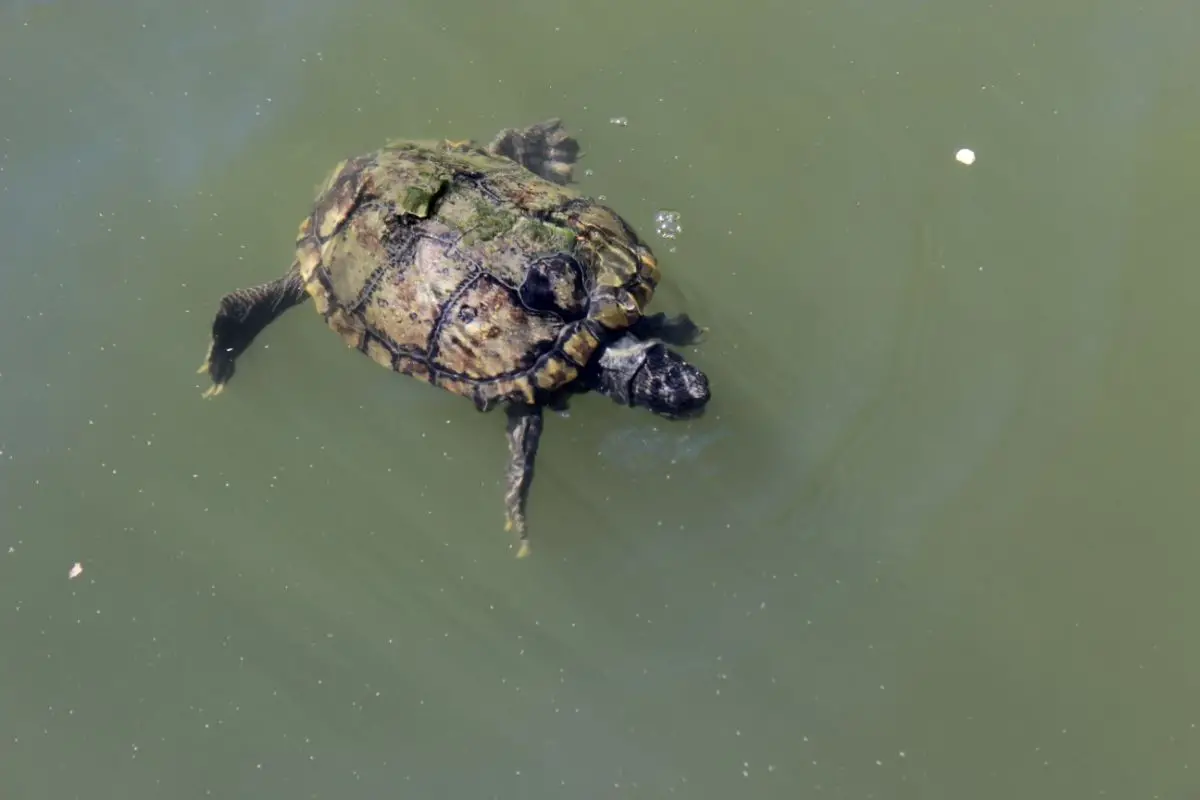
- Latin Name: Deirochelys Reticularia Miaria
- Other Names/Common Names: N/A
- Lifespan: These turtles naturally have a lifespan between 15 and 30 years.
- Adult Size: A mature adult Chicken Turtle will be between 4 and 10 inches from nose to vent.
Western chicken turtles are semi-aquatic reptiles that live in ponds or streams, and are the only chicken turtle subspecies in Texas. They’re native to the US and Mexico.
Despite living in the heat of Texas and Mexico, their preferred habitat is still water. Unfortunately, they are in danger of losing these preferred habitats, with ponds and swamps drying up all over the US.
If you are wanting to spot a western chicken turtle in the wild, look out for their long, striped necks, and rough, oval shaped shell.
Their shells usually have a flat shape, and a range of coloring from brown to olive with yellow swirls.
These turtles are omnivorous creatures that eat both plant life and other animals (such as crustaceans, invertebrates and fish). They prefer to live their lives in slower moving water.
The Missouri River Cooter
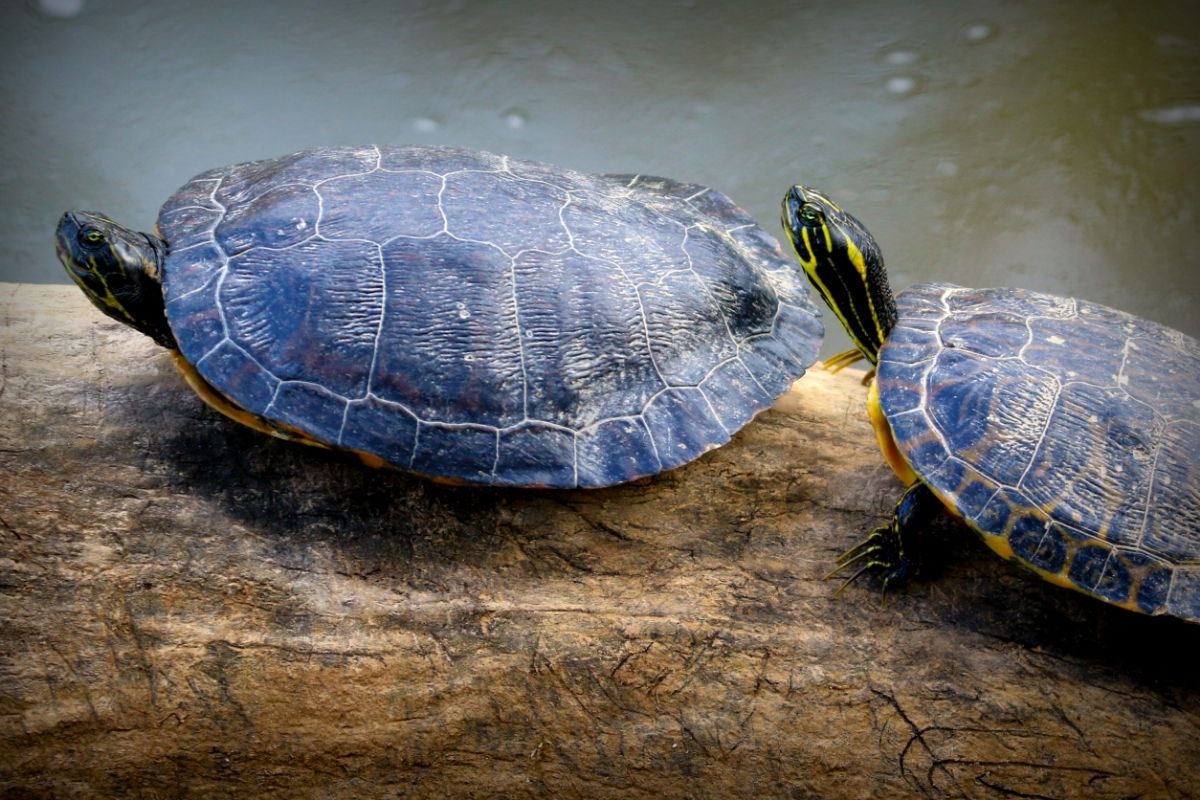
- Latin Name: Pseudemys Concinna Metteri
- Other Names/Common Names: N/A
- Lifespan: These turtles naturally have life spans between 20 and 40 years.
- Adult Size: A mature adult Missouri River Cooter is usually between 8 and 12 inches from nose to vent.
Missouri River Coots are semi-aquatic turtles that live in rivers and streams, and are a subspecies of the River Cooter that you have likely already seen out and about (they are one of the most common turtles in the US).
Their average lifespan is between twenty and forty years.
If you are wanting to spot one for yourself, then you are in luck, as they have a unique coloring pattern on their shell, they are a fairly common animal, and their range extends across the state.
Look for water rich areas – they prefer to live in areas of moving water, such as streams and rivers, in the eastern part of Texas.
The Missouri River cooter is one of the cheapest turtles on this list – as you can acquire one for a mere $20. These cooters are omnivorous creatures, but they do have a particular love of eating plants.
They like to bask at the beach and enjoy eating vegetation – so if you have one in a tank in your home, make sure you are hitting these core needs!
The Rio Grande Cooter
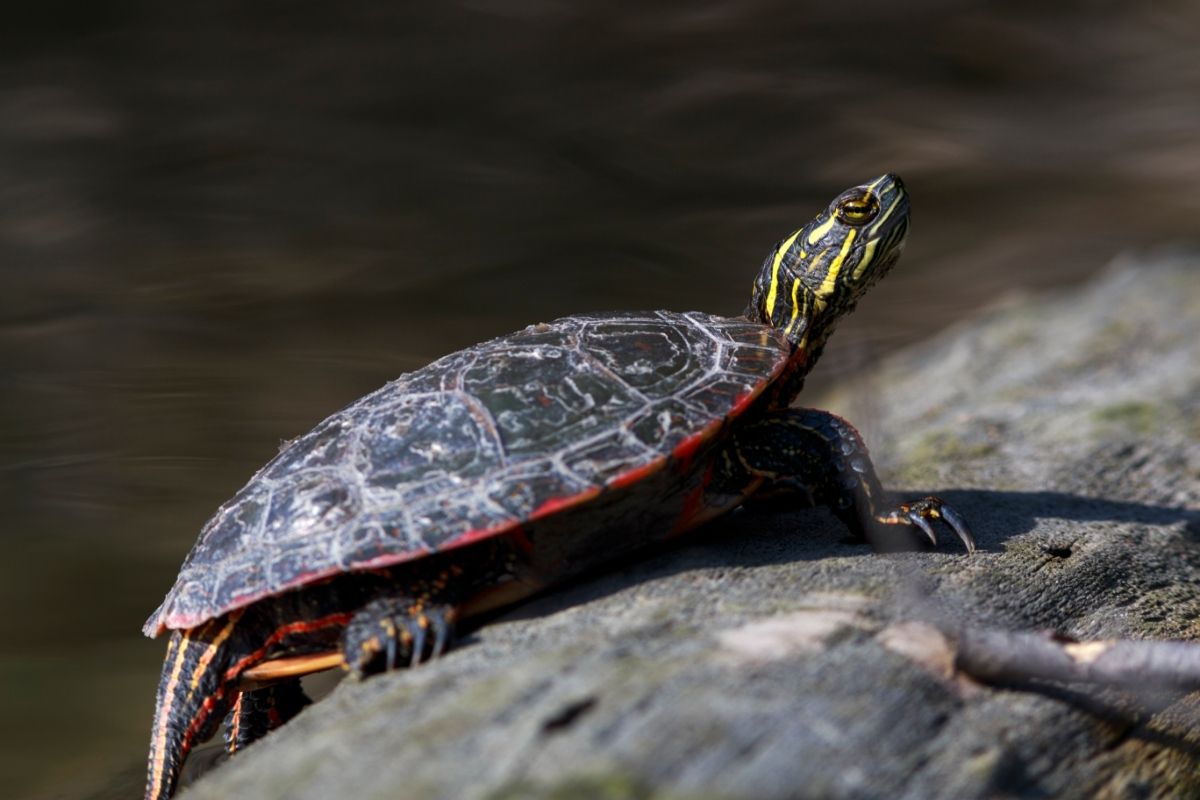
- Latin Name: Pseudemys Gorzugi
- Other Names/Common Names: the Rio Grande river cooter, the Western River cooter.
- Lifespan: These turtles naturally live between 20 and 40 years.
- Adult Size: A mature adult Rio Grande cooter turtle will be between 8 and 12 inches from nose to vent.
Rio Grand Cooters are also known as the Western River Cooter, and are another subspecies of the River Cooter.
The Rio Grande Cooter enjoys spending its time basking on the beaches along the Rio Grande (hence, their awfully inventive name), though this species is also found spread across many parts of the United States.
This turtle is omnivorous, and will basically eat whatever food is available to them. Like the Missouri River Coot, the Rio Grande Cooter prefers slow-moving waters for its homes.
A turtle lives between 20 and 40 years. They are also known as sliders because of their ability to slide along the ground, slipping from the river bank into the water on its belly.
If you want to spot one, look out for their oval shaped shell, and the distinctive yellow plastron stripes that they have on their head.
They also have jagged looking rearward scutes, and are sometimes covered in attractive colorful swirls, that are yellow, orange or red.
Cooters are omnivorous animals that mostly eat plants. They love basking on logs and rocks by the water.
You may also see them snacking on insects, but they aren’t great hunters, so most of their calories come from plant life.
You can purchase one of these pretty turtles for somewhere between the $70 and $100 mark.
The Texas River Cooter
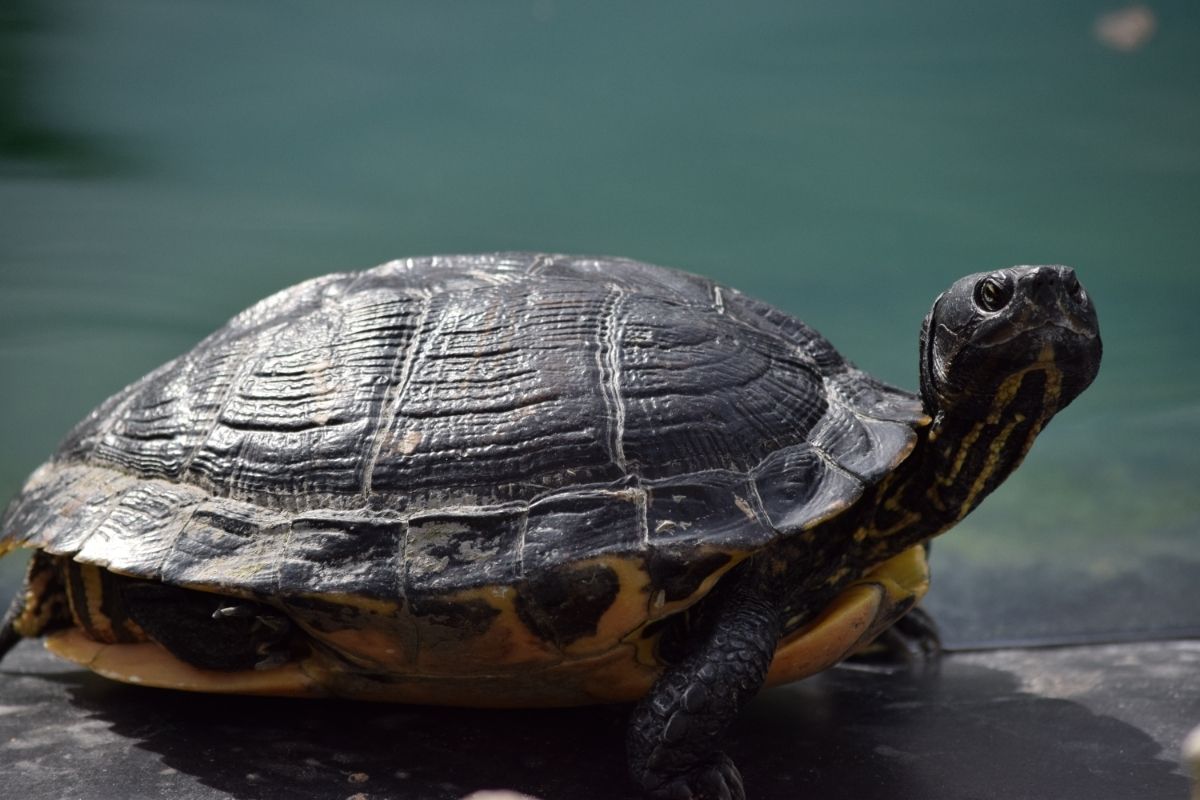
- Latin Name: Pseudemys Texana
- Other Names/Common Names: The Texas slider, the slider turtle
- Lifespan: These turtles naturally live between 20 and 40 years.
- Adult Size: A mature adult Texas river cooter will be between 7 and 12 inches from nose to vent.
These turtles are native to Texas, but can be found fairly commonly throughout the Gulf Coast states.
You can stop the Texas river cooter turtles basking on the shoreline of rivers, streams and lakes. You might even see them gathered in groups!
This kind of cooter comes in many colors – Texas cooters have shells that range from light green to olive-brown, covered by yellow stripes.
Their eyes are vertical, and they have a yellow stripe behind them. They are mostly herbivorous as adults, eating vegetation.
They also eat some insects and small fish – but, like other related cooter species, they aren’t the best hunters.
You can find them around the Gulf Coast. They prefer to stay in freshwater environments such as lakes and rivers, where they spend much of their time basking in shallow areas.
Like all sorts of aquatic turtles, the Texas river cooter is a good swimmer, and can move quickly through the water.
You can buy one of these cute little guys for anywhere between $20 and $50, so they are pretty inexpensive to purchase.
The Cagle’s Map Turtle
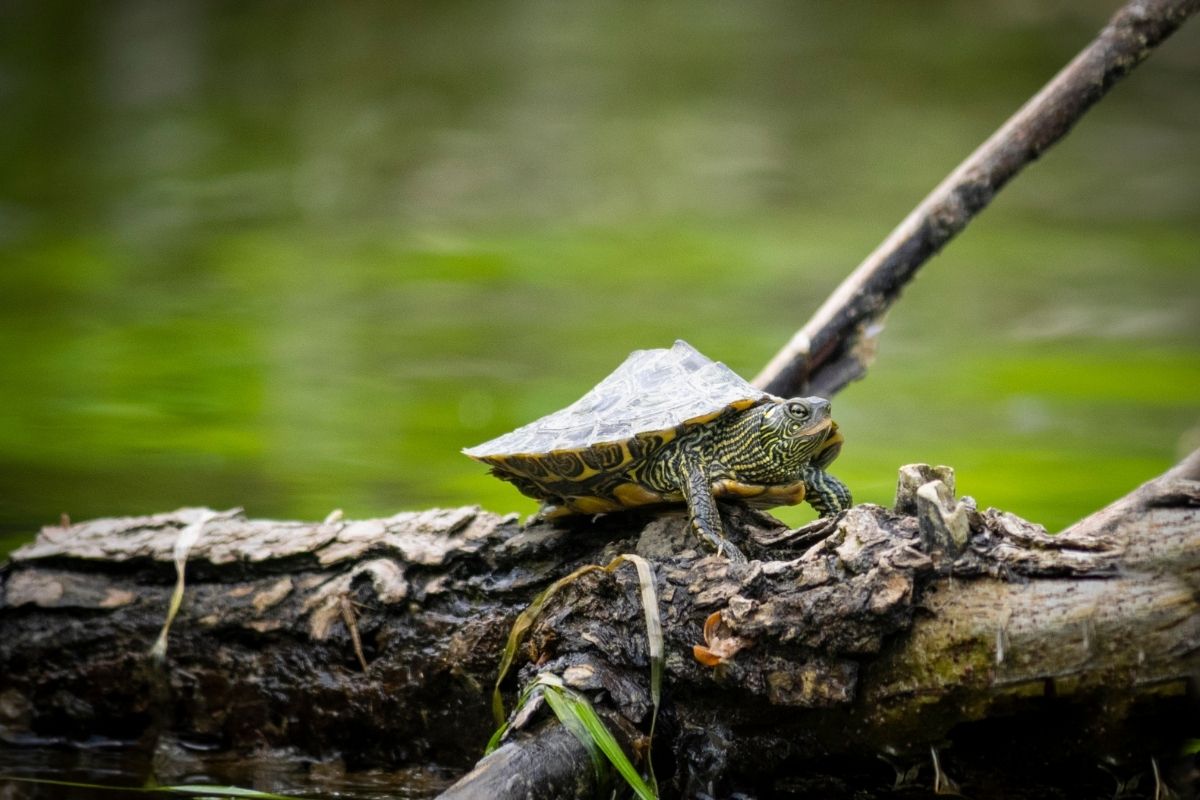
- Latin Name: Graptemys Caglei
- Other Names/Common Names: N/A
- Lifespan: These turtles naturally live between 30 and 50 years.
- Adult Size: A mature adult Cagle’s Map turtle will be between 3 and 5 inches from nose to vent (for males), and 8 to 10 inches (for females).
The Cagle’s Map turtle is a diamondback terrapin, named after the herpetologist Dr. Fred Ray Cagle. It is a subspecies or variety of map turtle that is endemic to the United States.
It is found in eastern North America from Canada to Florida and westward into Mexico.
This species is also known as the Alabama map turtle, Florida map turtle, Florida red-bellied turtle, gray map turtle, gray snapper turtle, northern map turtle, northern red-bellied turtle and red bellied turtle.
Cagle’s Map turtles’ shell colors vary depending on the region they’re found in. Their head markings also change based on the region.
They are often seen to eat insects and mollusks, but they sometimes eat plants, making them an omnivorous species with carnivorous leanings.
The Mississippi Map Turtle
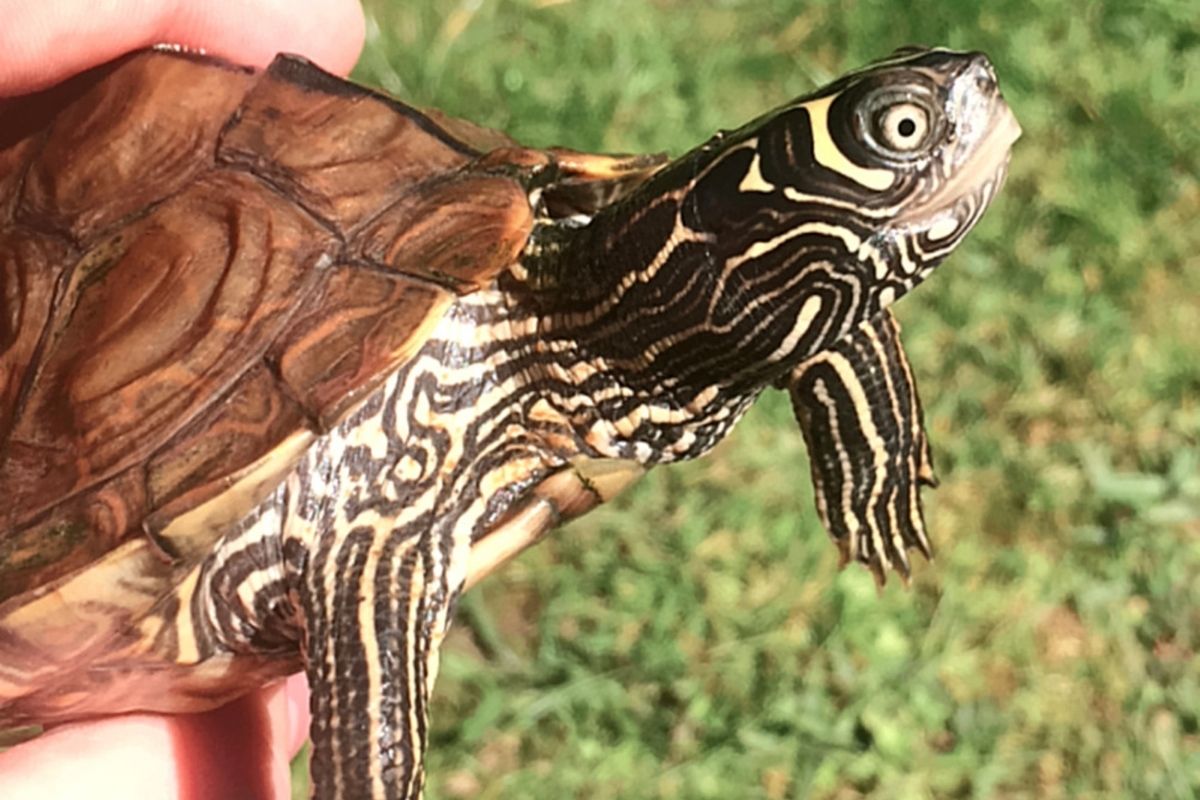
- Latin Name: Graptemys Pseudogeographica Kohnii
- Other Names/Common Names: The Sawback turtle
- Lifespan: These turtles naturally live between 30 and 50 years.
- Adult Size: A mature adult Mississippi Map turtle will be between 3 and a 1/2 and 10 1/2 inches long, nose to vent.
This is a subspecies of the common false map turtle. The Mississippi map turtles are found in eastern regions of Texas, and are the most common kind of mud turtle that is found in Texas.
If you are looking to spot a Mississippi map turtle, keep an eye out for their dark shells, which are usually brown or black and have a series of sharp-looking, black-tipped keels running the top of their shell.
Mississippi map turtles like to bask on rocks overhanging the water. They are mostly aquatic and rarely tray particularly far from water.
They consume aquatic invertebrates and crayfish, as well as chowing down on vegetation that they find underwater.
The Ouachita Map Turtle
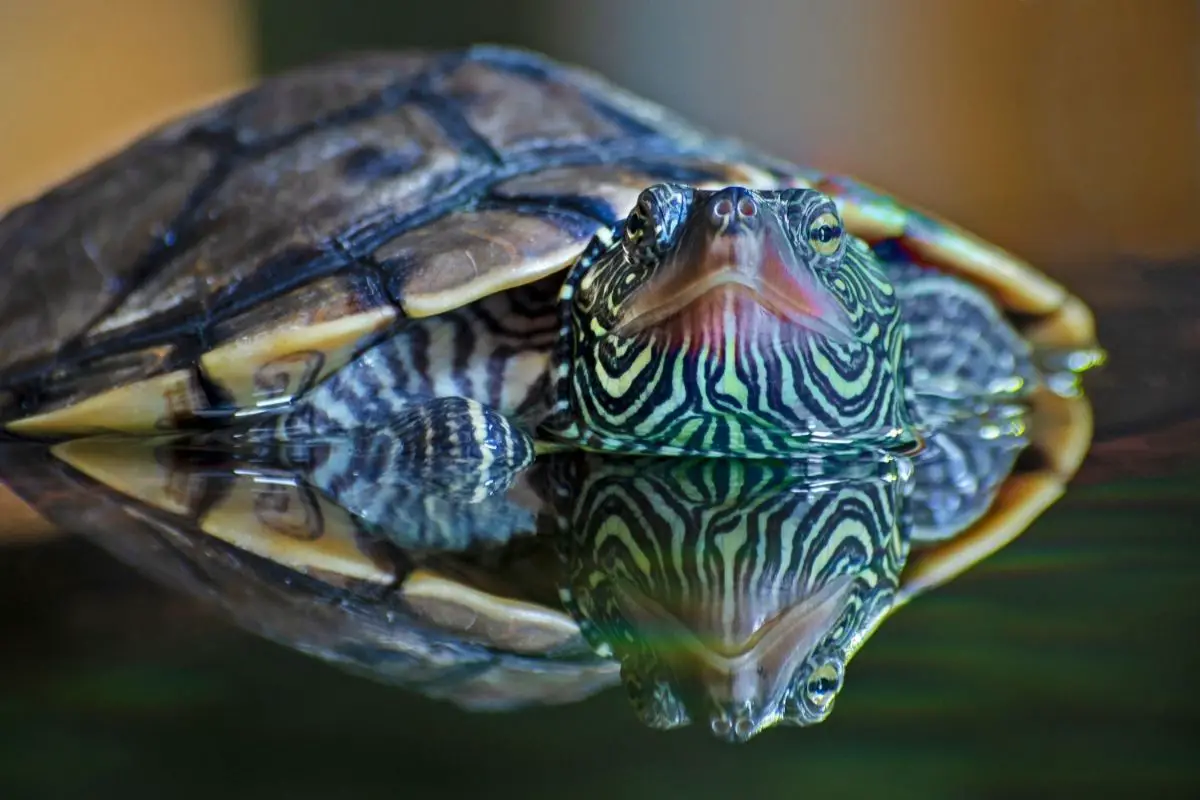
- Latin Name: Graptemys Ouachitensis
- Other Names/Common Names: N/A
- Lifespan: These turtles naturally live between 15 and 20 years.
- Adult Size: A mature adult Ouachita Map Turtle will be between 5 and 10 inches from nose to vent for the females, and 3 and a 1/2 to 5 inches for the males.
The Ouachita Map Turtle is a subspecies of map turtle that is native to the southeastern United States. They are commonly found along the banks of rivers and streams throughout the southeast.
They are typically found near the shoreline, and are not very active during the day.
However, when it comes time for mating season, these turtles can become quite aggressive towards other animals, especially if they are competing for mates.
During this time, they will travel up to several miles inland to find a suitable mate.
The Ouachita Map Turtles are primarily herbivores, eating mainly roots, tubers, fruits, seeds and vegetables. They are also opportunistic feeders, and will eat small fish, crustaceans and even amphibians.
The Sabine Map Turtle
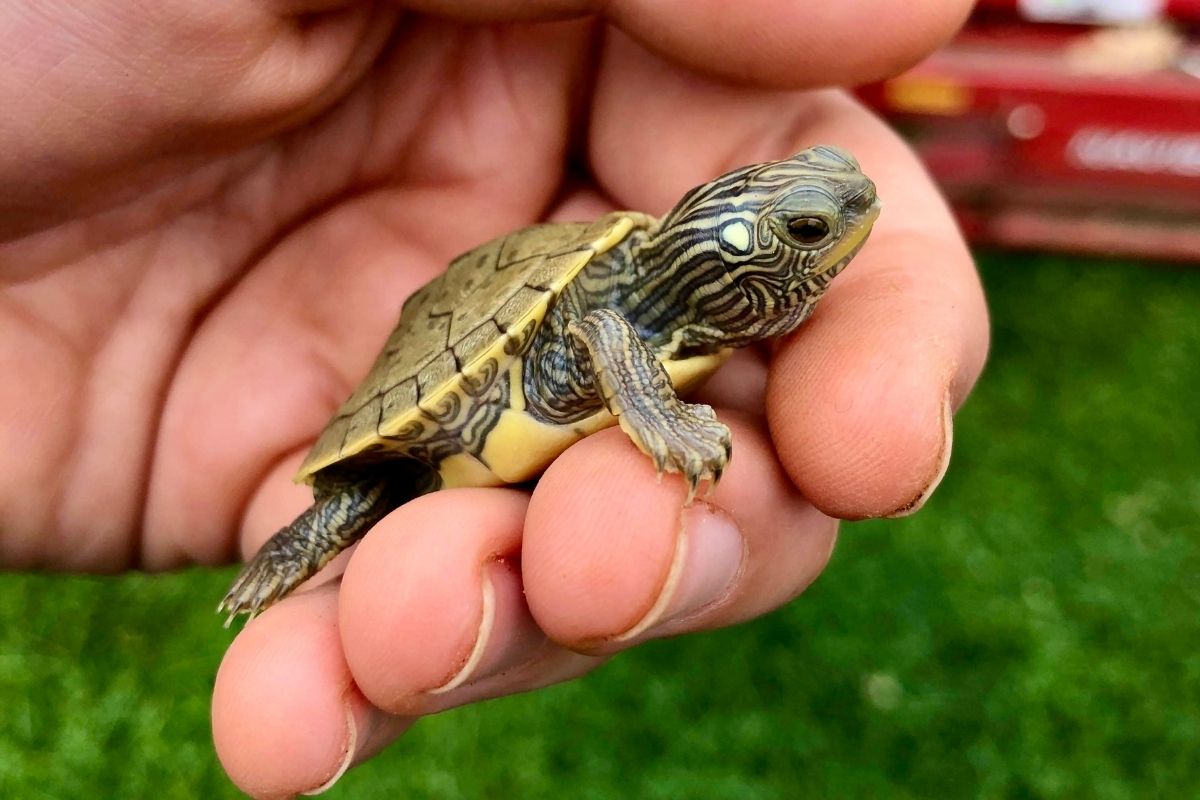
- Latin Name: Graptemys Sabinensis
- Other Names/Common Names: N/A
- Lifespan: These turtles naturally live between 30 and 50 years.
- Adult Size: A mature adult Sabine Map Turtle will be between 3 and 5 inches from nose to vent for males, and 8 to 10 for females.
The Sabine Map turtle is a subspecies of turtle that is native to Louisiana and Texas, which is related to the previously discussed Ouachita Map turtle.
It is also one of the smallest varieties of map turtle, being found only around the Sabine River of Texas. They are generally found in these areas of freshwater wetlands, in swamps and bayous, where they spend much of their lives.
They are omnivorous, meaning that they eat both plant and animal matter. For example, they eat insects, worms, snails, frogs, crabs, grasshoppers, and many more things.
They are also known to eat mussels and clams that they find along the riverbed.
In appearance, these turtles are quite striking, having olive green shells, which have spines running all the way down.
These ridges have black tips, making the Sabine map turtle distinguishable from all other map turtle varieties.
The Texas Map Turtle
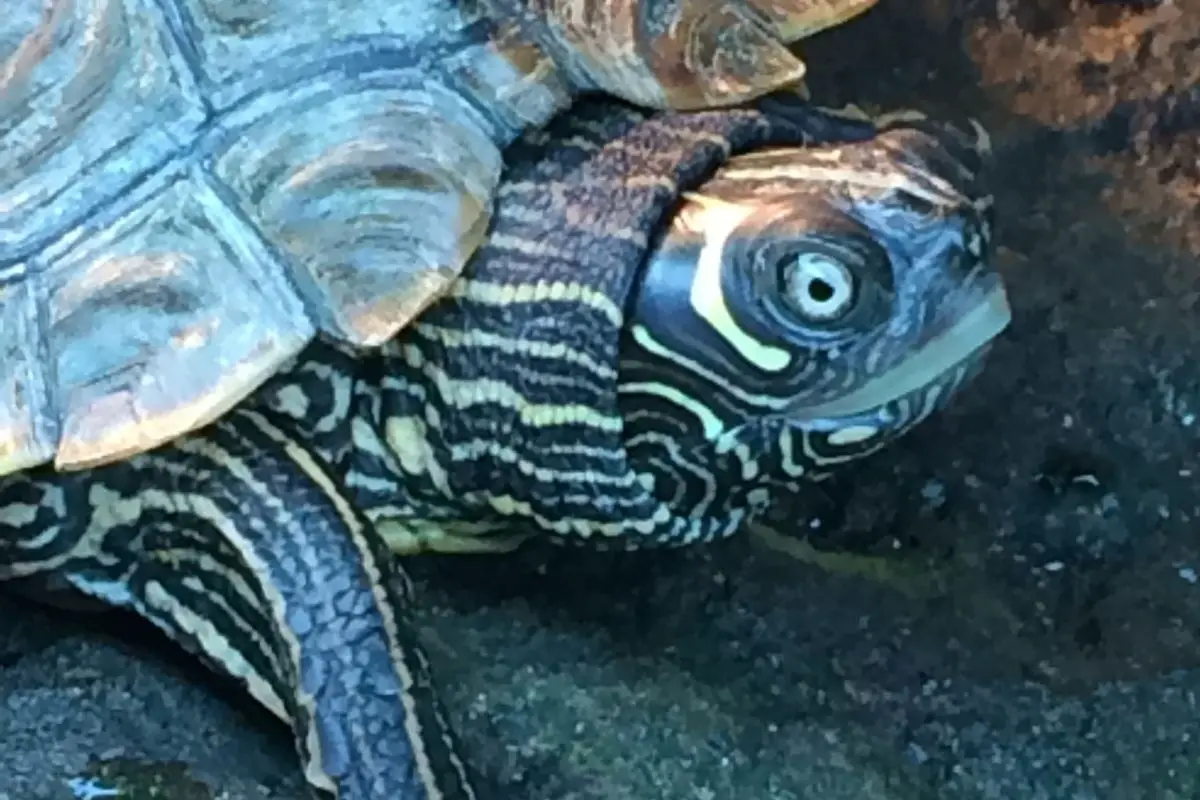
- Latin name: Grapetemysis Versa
- Other names/common names: N/A
- Life span: These turtles naturally live anywhere from 30 to 50 years.
- Adult size: A mature adult Texas Map Turtle will be between 4 and 7 inches from nose to vent, depending on the sex.
The Texas map turtle is a subspecies that is native to the southern part of Texas, including the Rio Grande Valley.
This variety of map turtle has been found in lakes, ponds, marshes, and even in marshy underground. Their diet consists mostly of aquatic plants and invertebrates.
These turtles are easily identified by the fact that they have a brownish-yellow shell with black spots. They also have dark stripes running down their backs.
In addition, they have an orange head and a white belly.
These turtles are omnivorous, and will eat anything they come across. They eat insects, spiders, worms, snails, and crabs. They will also eat vegetation such as leaves, stems, and flowers.
A hungry and skilled hunter may also eat small fish, and even some amphibians. However, one of their main eating patterns is that of a scavenger, meaning that they will pick up any food left behind by other animals.
The Eastern Mud Turtle

- Latin Name: Kinosternon Subrubrum
- Other Names/Common Names: The common mud turtle.
- Lifespan: These turtles naturally live between 30 and 50 years.
- Adult Size: A mature adult eastern mud turtle will be between 3 and 5 inches from nose to vent.
The eastern mud turtle is a subspecies native to North America. They are found throughout most of the East Coast states, and also in Canada. They are also found in the Midwest, but are less common there.
The Eastern Mud turtles are usually found in shallow water, or near the shoreline. They are omnivores, eating mainly aquatic plants, insects, and invertebrates.
They can also eat smaller vertebrate animals like crayfish, frogs, and salamanders.
This turtle is easy to identify because it has a large body and a short tail. Its coloration varies greatly, and depends on what type of environment it is living in.
If it is living in freshwater, its shell will be light colored. However, if it is living in saltwater, then its shell will be darker.
This turtle is very adaptable, and can survive in almost any kind of habitat. It can live in freshwater, brackish water, salt water, and even deep ocean waters.
They can also thrive in habitats that are not suitable for other kinds of reptile – overall they’re very hardy. This may boil down to their ability to bury down into the mud of their surroundings to hibernate.
In spite of their adaptability, they do thrive best in areas of slow moving water – like bogs and swamps, and are found in the greatest population density in the eastern and central parts of Texas.
The Rough-Footed Mud Turtles
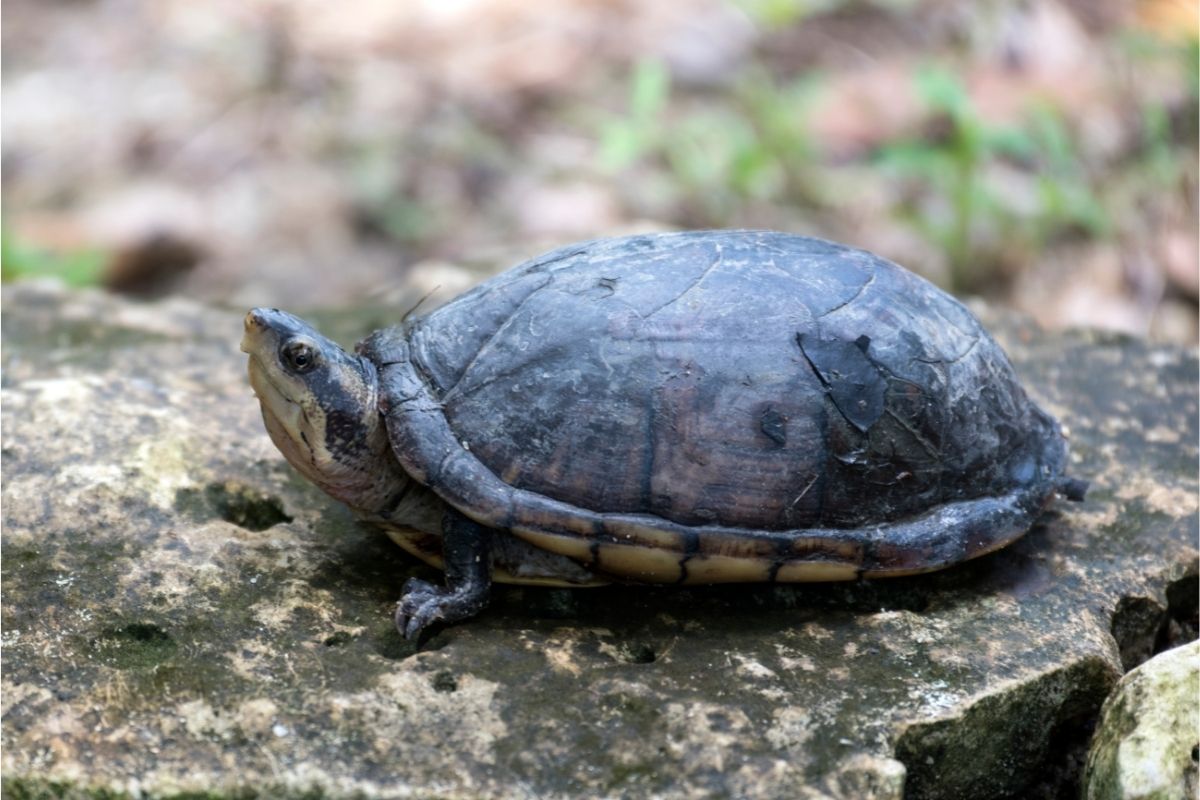
- Latin Name: Kinosternon Hirtipes
- Other Names/Common Names: Big Bend Mud turtle, Chihuahuan Mud turtle
- Lifespan: These turtles naturally live between 30 and 50 years.
- Adult Size: A mature adult rough-footed mud turtle will be between 5 and 7 inches from nose to vent.
Rough-footed turtles are native to Mexico, Central America, and the Southwestern United States. They are found in both freshwater and saltwater environments.
They are omnivorous, eating mainly aquatic plants and invertebrate animals. Furthermore, they will also eat small vertebrate animals like crayfish, frogs, and small fish.
They are easily identifiable because they have a long neck and a short tail. Their shells are typically olive green, with a few yellow spots.
They have a broad, flat head, which helps them burrow through the sand when they are looking for food. They are also able to move quickly underwater, making them good at escaping predators.
Like all turtles, these need a lot of space to live in. They prefer to live in areas where there is plenty of vegetation, and lots of moist soil. They love to live in wetlands, swamps, and marshes.
Furthermore, they are often found in places where the water level is low, so they can get out of the way of larger creatures.
These turtles are very tolerant of temperature changes, and can withstand temperatures ranging from 0 degrees Fahrenheit to 100 degrees Fahrenheit.
They can also tolerate high levels of humidity. They can also tolerate being submerged up to their necks in cold water, as well as being exposed to direct sunlight.
The Yellow Mud Turtle
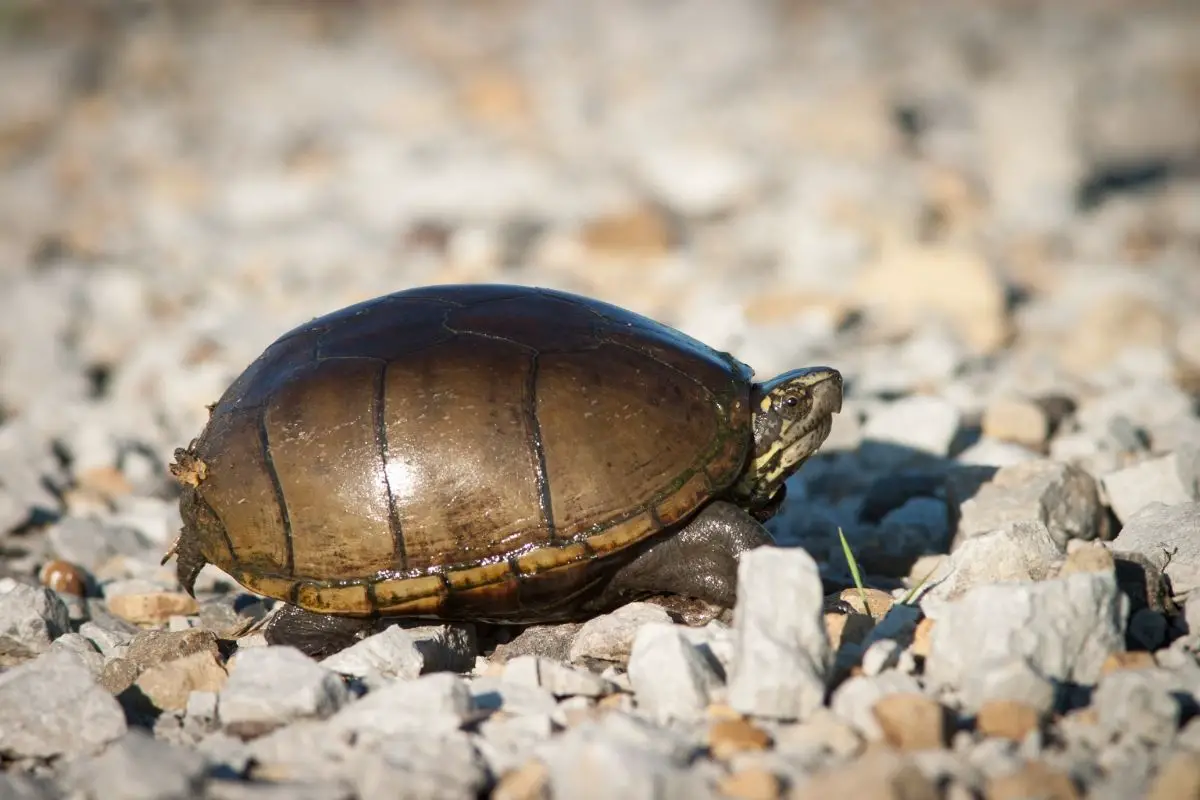
- Latin Name: Kinosternon Flavescens Flavescens
- Other Names/Common Names: Yellow-necked Mud Turtle
- Lifespan: These turtles naturally live between 10 and 40 years.
- Adult Size: A mature adult yellow mud turtle will be between 3 and 5 inches from nose to vent.
Yellow mud turtles are native to North America, and are found throughout the southeastern part of the continent. They are found in freshwater and saltwater environments, but prefer to live in freshwater.
They are omnivores, eating mostly aquatic plants and invertebrates, as well as some smaller vertebrate animals like crayfish, frogs, and fish.
Not only that, but they have a broad, flattened head, allowing them to burrow through the sediment on the bottom of the lake or stream.
Not only that, but they are also capable of swimming fast enough to escape predators, meaning it is rare for one to be eaten.
Because they live in shallow bodies of water, they are vulnerable to pollution and human activity. They are also susceptible to disease and parasites.
Because of this, it is important to keep your pond clean and free of pollutants. It is also important to protect your turtles from other animals that may want to eat them.
The Common Musk Turtle
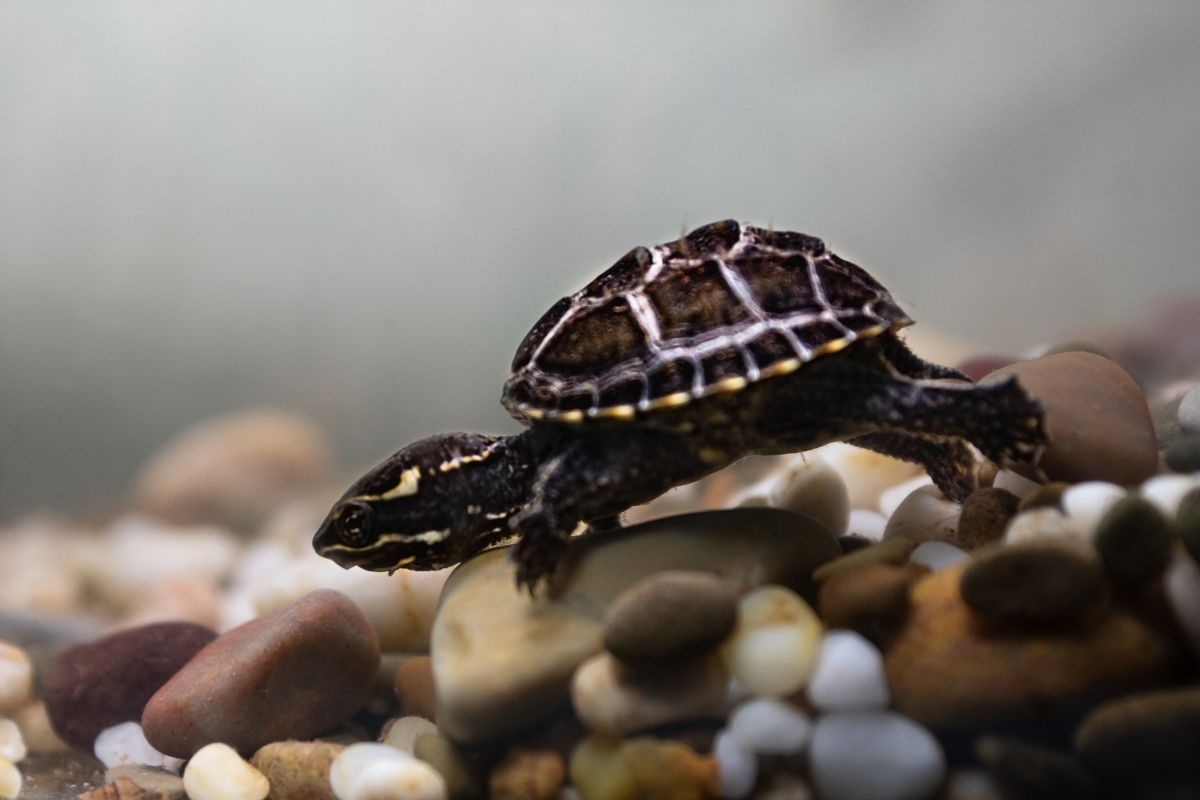
- Latin Name: Sternotherus Odoratus
- Other Names/Common Names: The Stinkpot, Eastern Musk turtle
- Lifespan: These turtles naturally have a lifespan above 50 years.
- Adult Size: A mature adult common musk turtle will be between 4 and 5 inches from nose to vent.
Musk turtles are native to North and South America. They are found in freshwater and brackish water environments. They are omnivorous, eating mostly aquatic plants, insects, and crustaceans.
Musk Turtles are easily identified by their stink – their ability to produce an unpleasant odor has earned them the colloquial name ‘stinkpot’.
They have a long snout, and a broad, flattened head. This allows them to dig into the mud on the bottom of the body of water.
They are also capable swimmers, and can swim faster than most other species of turtle that are found in Texas – making them hard to catch!
Musk Turtles are more sensitive to pollution than other species of turtles. They are also susceptible to diseases and parasites.
Like many other turtles, they are vulnerable to predation from raccoons, opossums, snakes, birds, and dogs.
The Razor Backed Musk Turtle
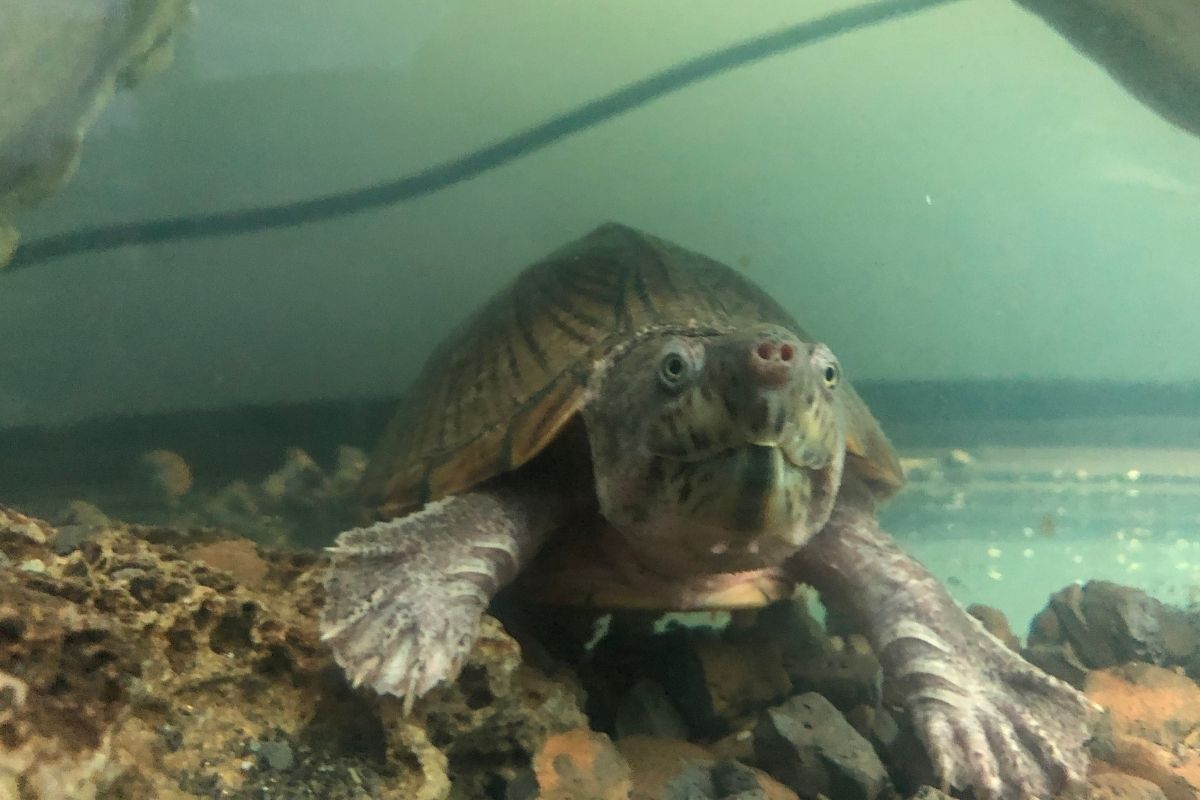
- Latin Name: Sternotherus Carinatus
- Other Names/Common Names: N/A
- Lifespan: These turtles naturally live between 25 and 50 years.
- Adult Size: A mature adult razor backed musk turtle will be between 5 and 6 inches from nose to vent.
Razor back turtles are native to the eastern United States, and are found in both fresh and saltwater. They are omnivorous, eating mainly aquatic plants, insects, mollusks, and small vertebrate animals such as crabs and shrimp.
Razorbacks are easy to identify because of their distinctive pattern of dark stripes running down their back.
Their shell is very thin and flexible, which helps them to move quickly through the water. The scute look like razor lined humps – a look which has definitely inspired their name.
They can be differentiated from other musk turtles because of their black markings – their skin is covered on black dots, and a black lines stretch across the length of their shell.
The Painted Turtle
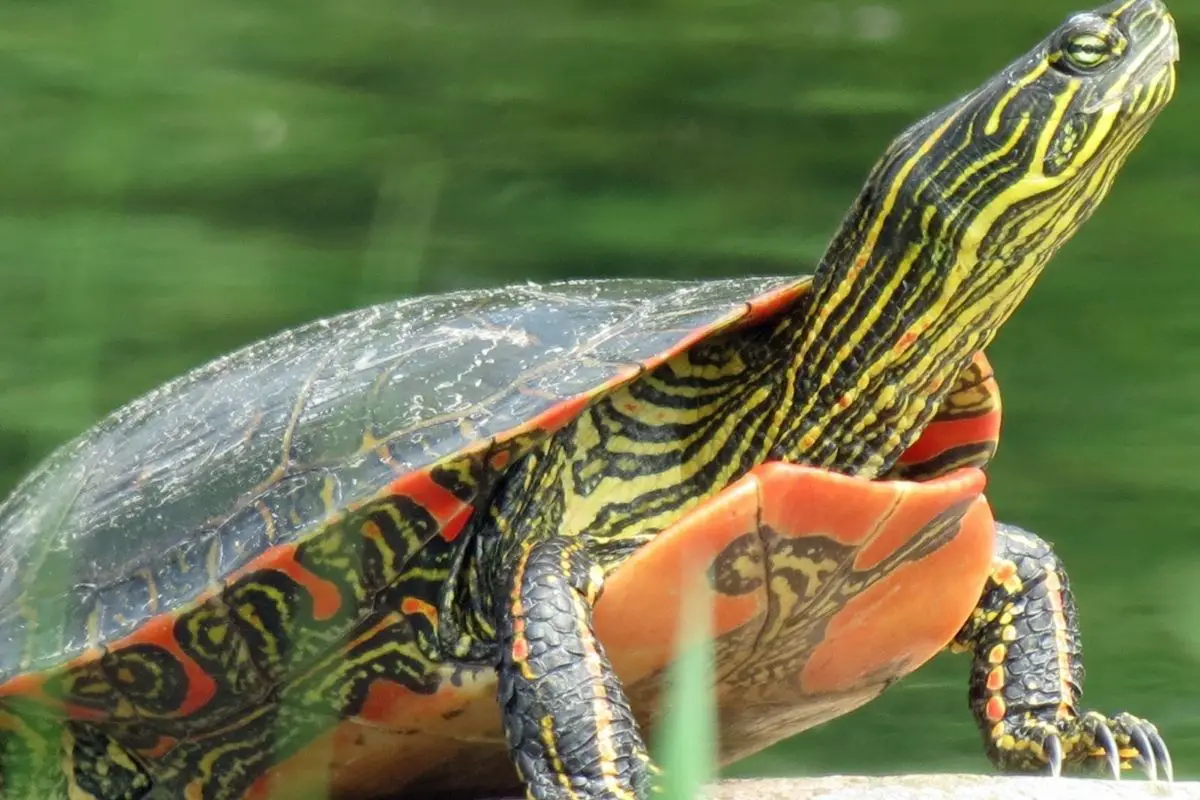
- Latin Name: Chrysemys Picta
- Other Names/Common Names: N/A
- Lifespan: These turtles naturally live between 30 and 50 years.
- Adult Size: A mature adult painted turtle will be between 4 and 10 inches from nose to vent.
Painted turtles are native to North America. They are found throughout the continent, but are most abundant in Florida and Louisiana.
They are omnivorous, eating primarily plants and invertebrates. Furthermore, they are a fully aquatic species that prefer to stay near the water and bask in the sun.
These turtles are not commonly seen in Texas. However, there is one population near San Antonio that can be found on the Guadalupe River.
There are actually two species of painted turtle found in Texas – the Southern Painted turtle (which has the Latin name Chrysemys picta Dorsalis) and the Western Painted turtle (which has the Latin name Chrysemys Picta Bellii).
You can tell if a turtle you have seen is a painted turtle by looking for their distinct markings. They have dark shells, which are often edged in red and yellow stripes.
They are distinguished from other subspecies that are found elsewhere in the USA by the orange and yellow band that runs down the length of the spine of the carapace.
The Big Bend Slider Turtle
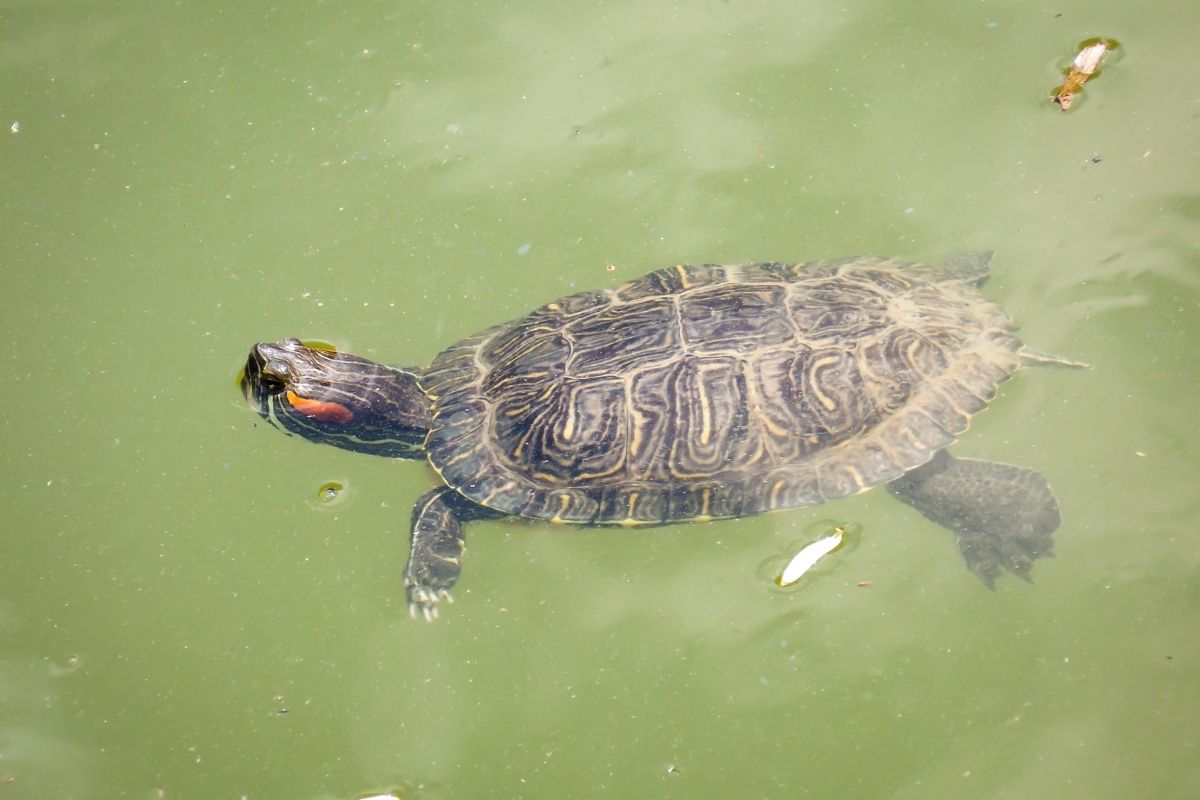
- Latin Name: Teachemys Gaigeae
- Other Names/Common Names: The Mexican Plateau slider
- Lifespan: These turtles naturally live between 20 and 30 years.
- Adult Size: A mature adult big bend slider turtle will be between 5 and 11 inches from nose to vent.
This turtle is native to Mexico and Central America. It was once common in Texas, but it is now classed as a threatened species, and is a lot more difficult to spot.
The big bend slider lives in rivers and streams with rocky bottoms – in particular, it lives in the area around the Big Bend river. They spend much of their time basking in the sun, so they need a large expanse of open space.
If you find one, make sure you keep an eye out for its distinctive coloration. This turtle’s shell is dark green, or brownish-gray, and it has a long tail. Its head is also distinctive – it looks like a flattened oval, with a pointed snout.
The Red Eared Slider Turtle
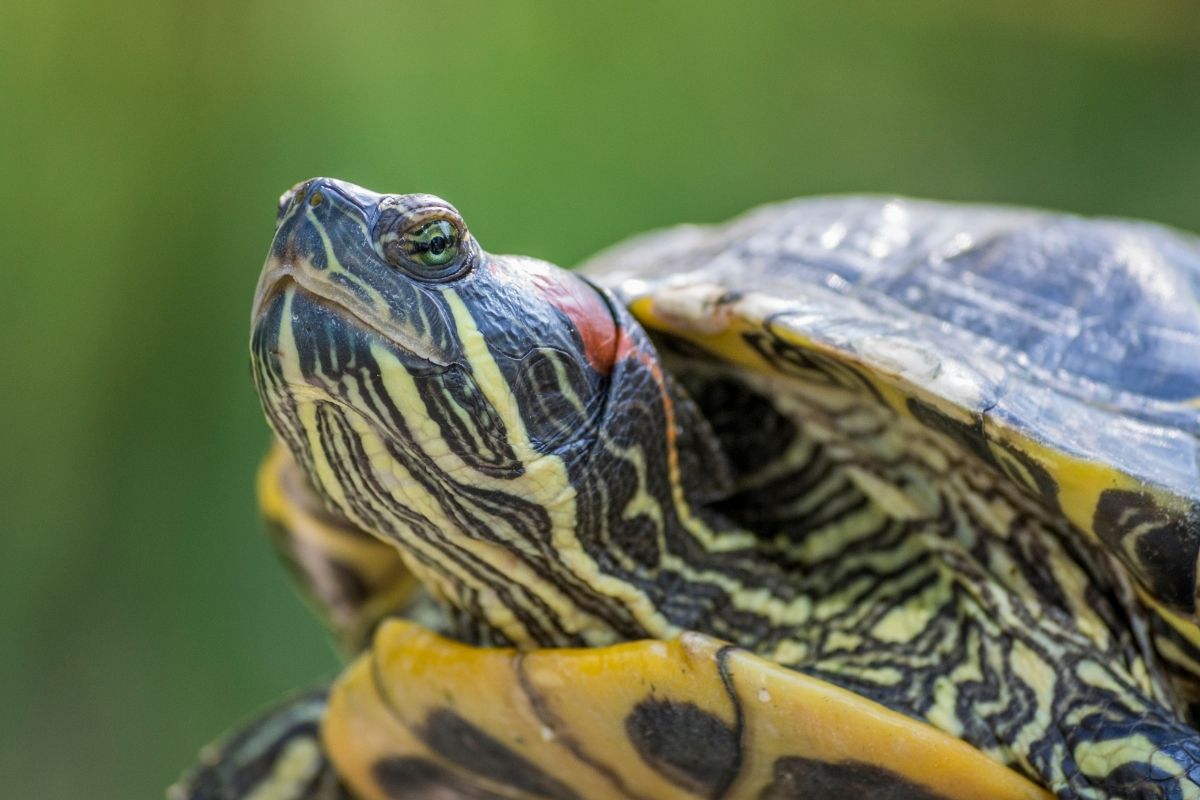
- Latin Name: Trachemys Scripta Elegans
- Other Names/Common Names: The water slider turtle, the red eared terrapin
- Lifespan: These turtles naturally live between 20 and 40 years.
- Adult Size: A mature adult red eared slider turtle will be between 6 and 8 inches from nose to vent.
This turtle is native only to North America. It is found throughout Canada and the United States, and it is found in droves throughout waterways in Texas.
Like the big bend slider, the red eared slider spends much of its day basking in the sun.
With a sharp eye, you will be able to spot these turtles basking at the water’s edge, and they often like to stack themselves on top of each other, forming little towers of terrapins.
They like to have lots of room to do this, so they prefer areas where there are plenty of rocks. They can be found in slow-moving waters, like lazy freshwater rivers and lakes.
The red eared slider turtle has an omnivorous diet, eating both underwater vegetation, and small invertebrates and fish.
You can tell if a turtle you see is a red eared slider by their olive green shell, and the yellow markings that are on their scales.
They have dark colored heads, with yellow bands of color round their skull, and red patches of color situated just behind their eyes.
The Alligator Snapping Turtle

- Latin Name: Macroclemys Temminckii
- Other Names/Common Names: Loggerhead Snapper
- Lifespan: These turtles naturally live between 60 and 70 years.
- Adult Size: A mature adult alligator snapping turtle will be between 15 and 26 inches from nose to vent.
Alligator snapping turtles are native to eastern North America. They prefer fresh water environments, and they are most frequently found in rivers and streams.
They are very aggressive when they feel threatened, and they are known to attack humans, especially during their mating season, when hormones are running very high.
Alligator snapping turtles will basically eat almost anything that moves, including fish, frogs, crayfish, and even small mammals such as mice – so they are a carnivorous kind of turtle, making them different to most other animals on this list!
If you come across an alligator snapping turtle, don’t approach them! They’re not afraid to fight back, and they may bite your hand off. Instead, leave them alone, and let them go about their business.
If you want to help protect these turtles, then you should try to avoid disturbing them.
Don’t feed them, avoid going near their nests of eggs, and don’t disturb them while they’re resting. They love some peace and quiet!
The Common Snapping Turtle
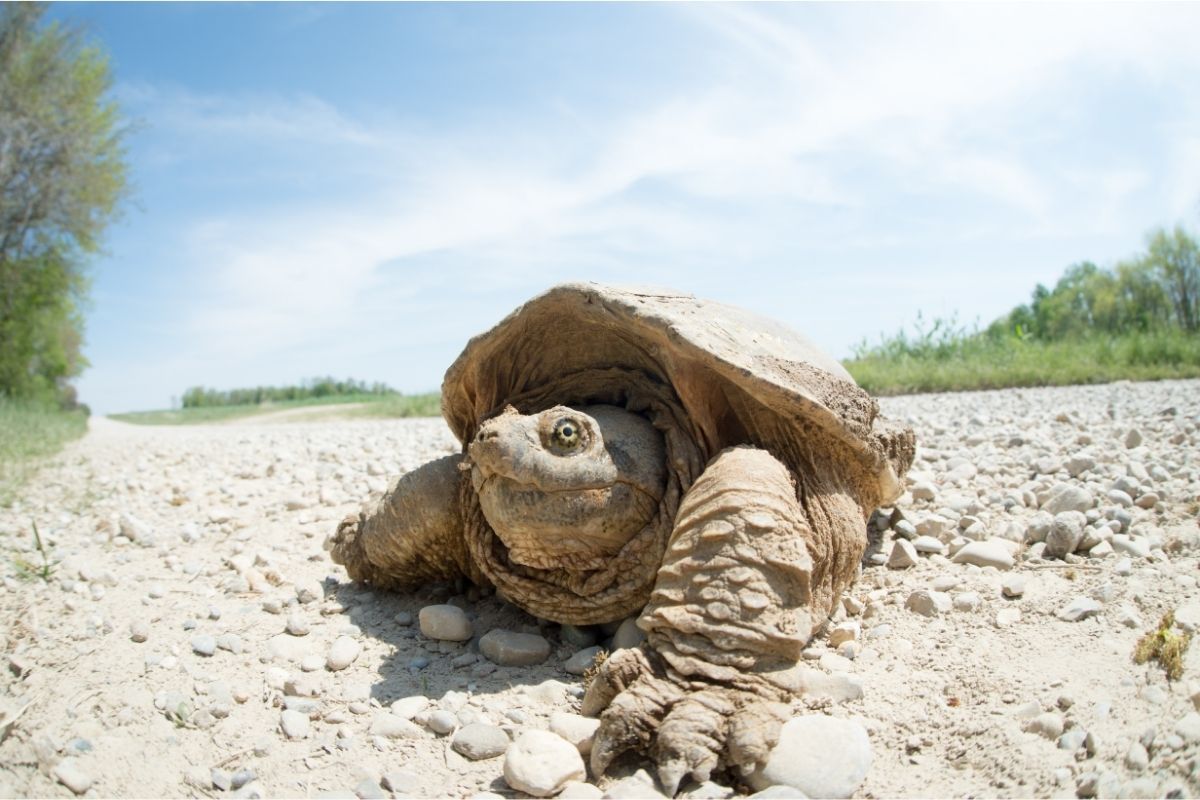
- Latin Name: Chelydra Serpentina
- Other Names/Common Names: Common Snapper, Eastern Snapping turtle, Snapper
- Lifespan: These turtles naturally live between 30 and 50 years.
- Adult Size: A mature adult alligator snapping turtle will be between 8 and 20 inches from nose to vent.
These turtles are native to the southeastern part of the United States, and they prefer freshwater environments.
They are also commonly referred to as “snappers”, because they snap up any food items that move – and maybe even your fingers, if you get too close!
They are one of the few turtles that can swim backwards, which helps them escape predators (in addition to their strong, snapping beak).
Snapping turtles spend a lot of time basking in the sun, and they are usually seen along the shoreline or floating in open bodies of water.
When they bask, they’ll raise their head above the surface of the water, exposing themselves to sunlight.
This allows them to absorb more heat energy, and it makes them less likely to get eaten by predators, as they can escape quickly in the water.
This species is well known for their hooked beak, and have both a set of strong claws, and a long, saw-toothed tail.
Snapping turtles are omnivores, meaning that they eat both plants and animals.
They are opportunistic feeders, and they will eat whatever they find. They prefer eating things like snails, worms, insects, crustaceans, mollusks, and aquatic vegetation.
Furthermore, they are also known to eat fish, amphibians, birds, and reptiles, if they can get their hooked beak onto them.
You can help protect these turtles by avoiding feeding them, and by keeping away from their nesting areas. If you see a nest, please do NOT touch it, and DO NOT take any of the eggs.
The mother turtles will return to lay a new clutch later, and she will definitely appreciate it if you leave her alone.
The Midland Smooth Softshell Turtle
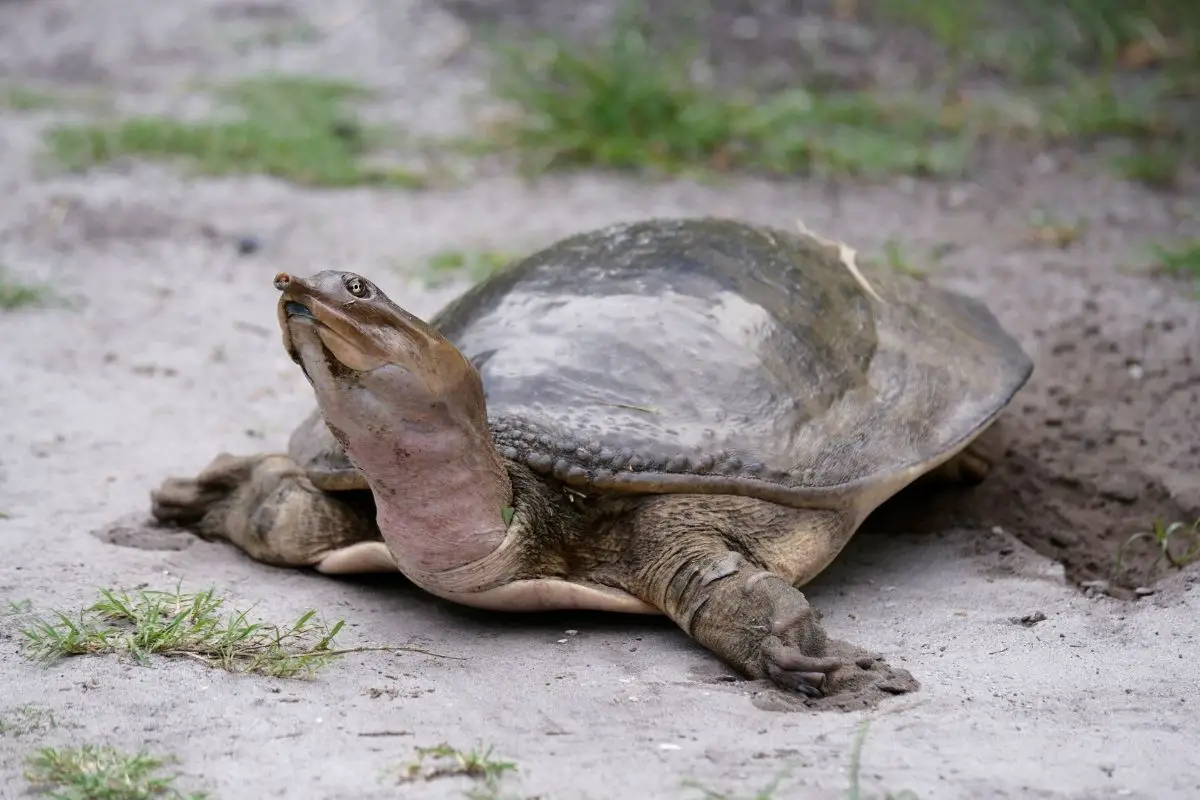
- Latin Name: Apalone Mutica Mutica
- Other Names/Common Names: The Spineless Softshell
- Lifespan: These turtles naturally live above 25 years.
- Adult Size: A mature adult smooth softshell turtle will be between 4 and 1/2 and 7 inches from nose to vent for males, and 6 and a 1/2 to 14 inches for females.
Smooth softshells are found throughout North America, but they are most common in Florida. They are considered semi-aquatic, because they spend a large amount of time on land, but they also enjoy spending time in the water.
In fact, they are so comfortable in the water, that they actually use their shells as flotation devices when they need to travel through the water.
They are also very agile swimmers, and they can easily outrun many other types of turtles.
Like snapping turtles, smooth softshells are omnivorous, meaning that they eat plants and animals. They prefer eating things such as snails, slugs, earthworms, insects, crustaceans, mollusks, and aquatic vegetation.
However, they are not picky eaters, and they will readily consume anything that moves.
They are also territorial, and they will defend their territory against other smooth softshells, as well as other animals. They will often bite at intruders, and they may even try to drag them into the water.
Not only that, but they are especially aggressive towards other types of turtles, and they will chase and attack them.
The Spiny Softshell Turtle
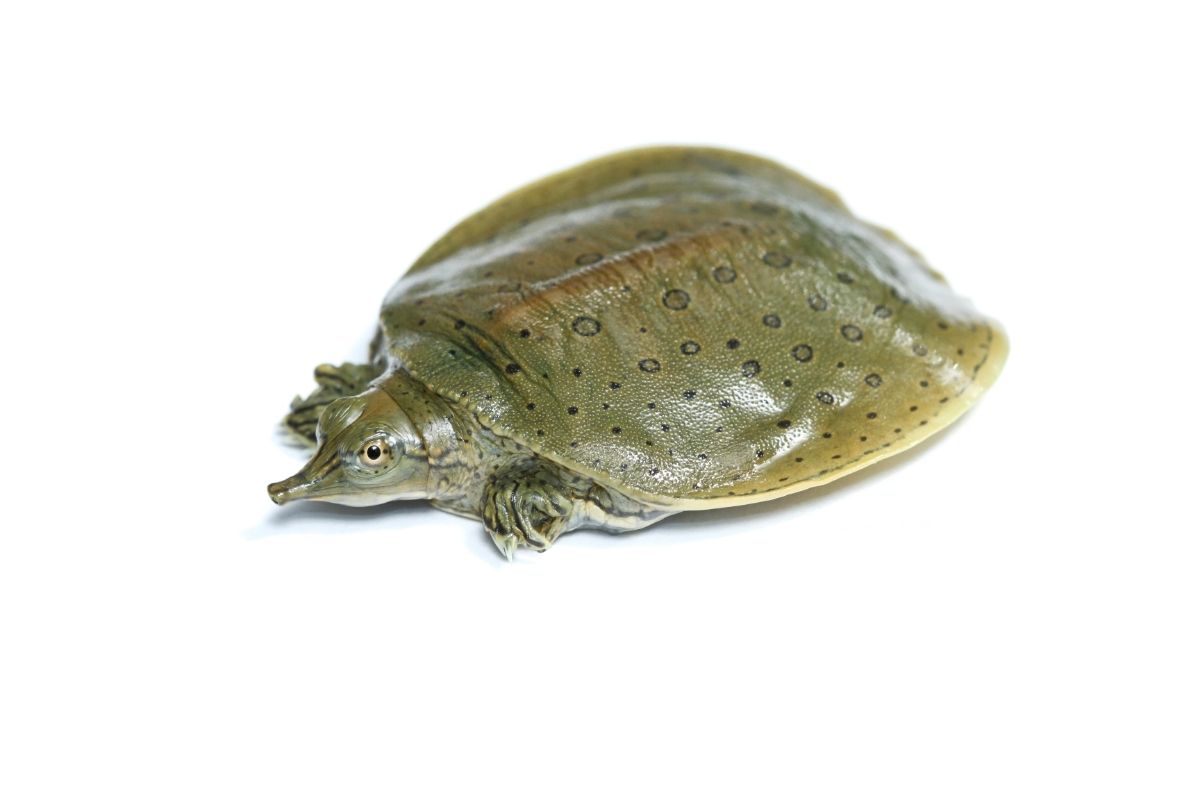
- Latin Name: Apalone Spinifera
- Other Names/Common Names: N/A
- Lifespan: These turtles naturally live between 20 and 50 years.
- Adult Size: A mature adult spiny softshell turtle will be between 5 and 9 and 1/2 inches from nose to vent for males and 7 to 17 inches for females.
Spiny softshells are native to South America, and four subspecies of spiny softshells are found throughout Texas.
They are called “spiny” softshells because they have small spikes on their shell, which helps them keep themselves safe while swimming – deterring predators.
They are also quite adept swimmers, and they are able to swim much faster than most other types of turtles.
Spiny softshells are omnivorous, meaning that they eat everything from plants to animals. They prefer eating foods like snails, slugs and earthworms, insects, crayfish, mollusks, and aquatic vegetation.
However, unlike other species of softshells, they are not particularly fond of fish or meat. They have a very distinctive long and tapered beak, which they use to breathe whilst they are buried in the sand, and waiting for prey to pass by.
These turtles are extremely territorial, and they will fight with other types of turtles, including snapping turtles.
When threatened, they will often lash out with their claws, leaving attackers with painful scratches and bites.
The Texas Diamond-Backed Terrapin
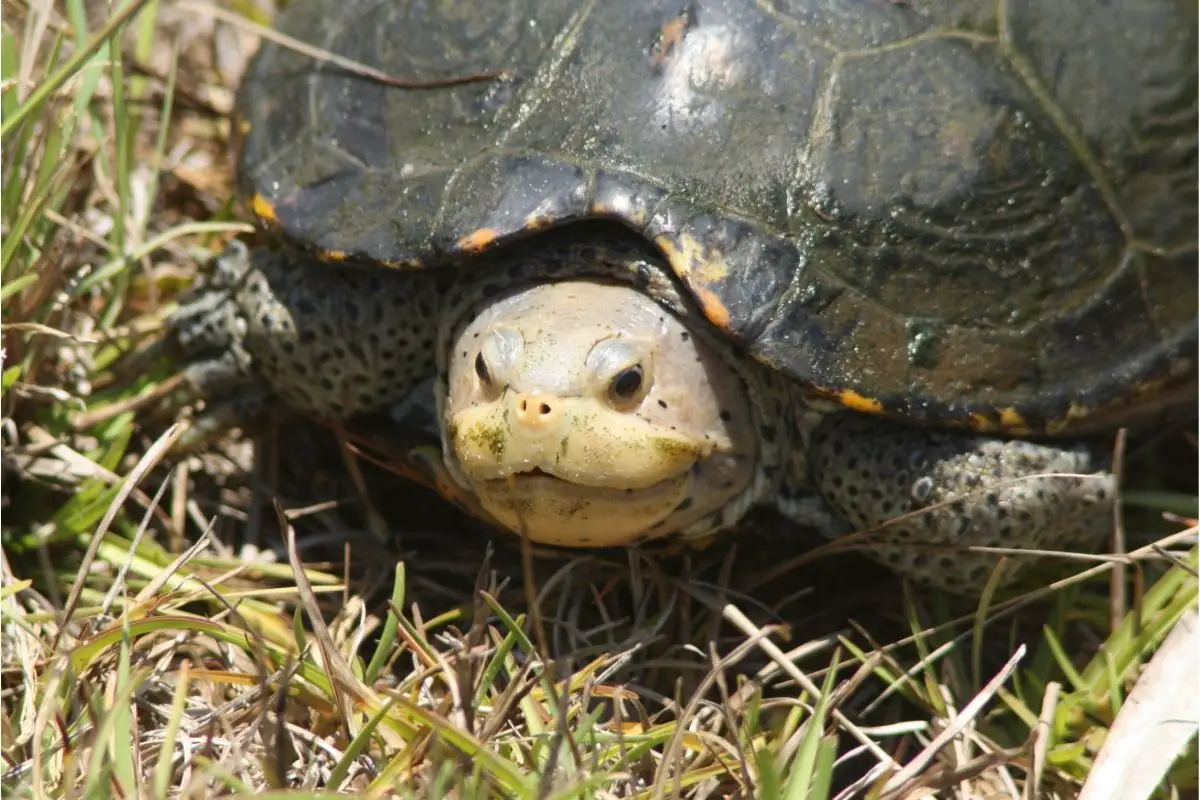
- Latin Name: Malaclemys Terrapin
- Other Names/Common Names: N/A
- Lifespan: These turtles naturally live between 25 and 40 years.
- Adult Size: A mature adult diamondback terrapin turtle will be between 4 and 6 inches from nose to vent for males, and 5 and 8 inches for females.
Texas diamondback terrapins are native to South America.
There are actually two different subspecies of diamond-backed terrapins that are found throughout Texas, and these are known as the Texas diamond-backed terrapin (Malaclemys terrapin) and the Mexican diamond-backed terrapin.
The Texas diamond-backed terrapin is native to Mexico, Central America, and northern parts of South America.
The Mexican diamond-backed terrapin lives in rivers, lakes, and ponds, whereas the Texas diamond-backed terrapin lives in freshwater marshes, bays, estuaries, and coastal areas.
Texas diamond-backs are omnivorous. They prefer eating foodstuffs such as fruits, nuts, seeds, roots, bulbs, leaves, flowers, and fungi.
They are also quite good swimmers, and they can move quickly through shallow waters.
Like all terrapins, Texas diamond-backs are excellent burrowers. They dig holes in the ground for protection, and they also make nests for their eggs.
They will sometimes build nests up to 10 feet deep, and they will line the nest with grass and leaves.
The Green Sea Turtle
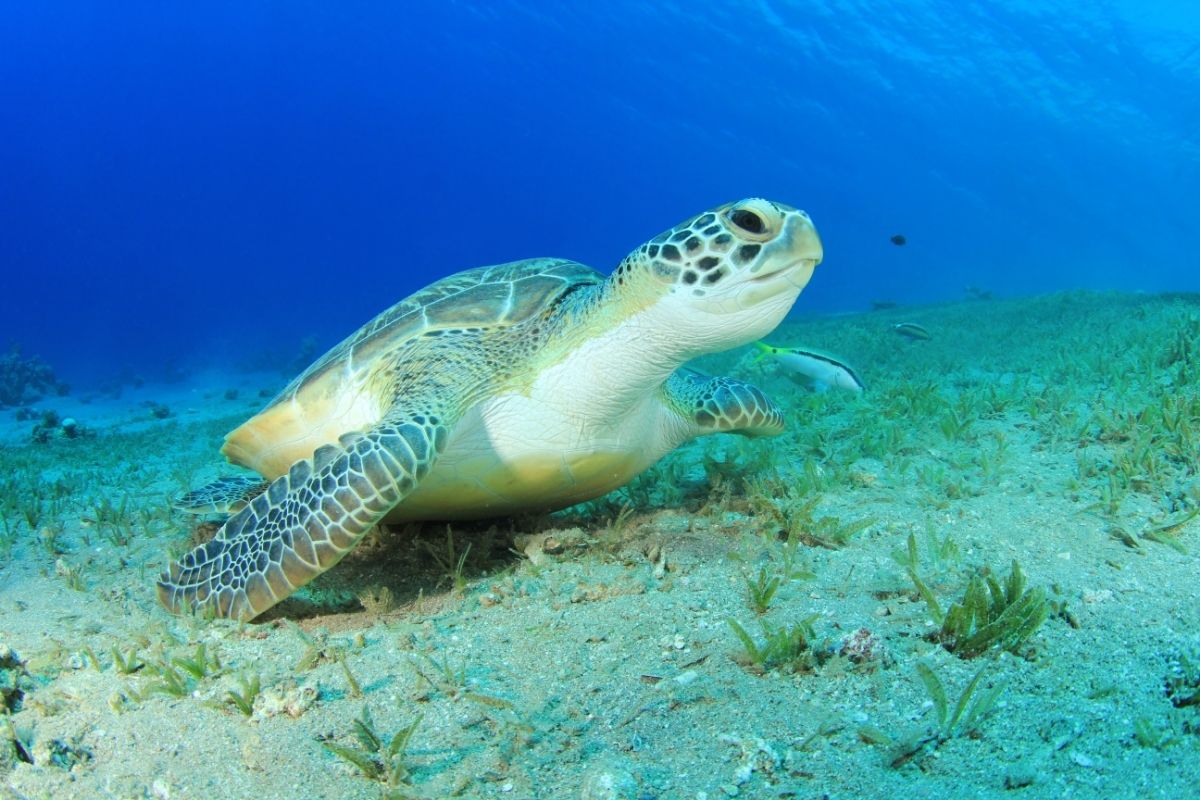
- Latin Name: Chelonia Mydas
- Other Names/Common Names: N/A
- Lifespan: These turtles naturally live between 80 and 100 years.
- Adult Size: A mature adult green sea will weigh 300 to 400 pounds.
- Conservation Status: Endangered
- Diet: They are herbivorous turtles, preferring to eat sea vegetation than any other kind of animal.
- Appearance: These turtles have a smooth shell that tends to be green or brown, with a bright yellow edge. Their shell is shaped like a heart, and they have creamy green scaled skin.
The Hawksbill Sea Turtle

- Latin Name: Eretmochelys Imbricata
- Other Names/Common Names: N/A
- Lifespan: These turtles naturally live between 80 and 100 years.
- Adult Size: A mature adult green sea will weigh 100 to 155 pounds, and 30 to 35 inches in length.
- Conservation Status: Critically Endangered
- Diet: They are an omnivorous turtle, eating algae, mollusks and crustaceans that they find in the sea.
- Appearance: These turtles have a prominent beak that tends to be green or brown. Their shell tends to be an amber color, and have a set of unique markings, like a human fingerprint.
Final Thoughts
In this list, we have covered an extensive set of the native species of turtles that are found throughout the state of Texas.
We have taken a deep look into the terrestrial turtles, the freshwater aquatic turtles, and a quick look at the well-known Texan sea turtles.
